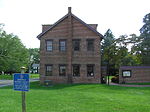Smithville, Burlington County, New Jersey

Smithville was a village in Eastampton Township, Burlington County, New Jersey. It was originally established as Shreveville in 1831 by Jonathan and Samuel Shreve as a textile village on the Rancocas Creek. It was purchased by Hezekiah Bradley Smith in 1865 and renamed to Smithville. The Smithville post office was established in 1866. The H. B. Smith Machine Company, which produced the American Star Bicycle beginning in 1880, was located there. In 1962, the Smithville Post Office was closed. In 1975, Burlington County purchased the property and created the first park in the county. It is listed on the National and New Jersey Registers of Historic Places as the Smithville Historic District.
Excerpt from the Wikipedia article Smithville, Burlington County, New Jersey (License: CC BY-SA 3.0, Authors, Images).Smithville, Burlington County, New Jersey
Smithville Road,
Geographical coordinates (GPS) Address Nearby Places Show on map
Geographical coordinates (GPS)
| Latitude | Longitude |
|---|---|
| N 39.985833333333 ° | E -74.748611111111 ° |
Address
Smithville Road 899
08060
New Jersey, United States
Open on Google Maps







